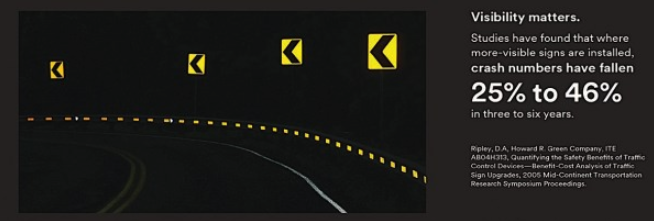On our roadways an accident can happen in the blink of an eye, whether you are a pedestrian at a crossing or driving down a lonely highway. At any given moment our destiny can be shaped by our actions or those of others.

According to the World Health Organisation, the lives of approximately 1.35 million people are cut short every year as a result of a road traffic crash. Between 20 and 50 million more people suffer non-fatal injuries, with many incurring a disability as a result of their injury. Although there are many elements to road safety, the ultimate goal is the same all over the world – that is, to work towards achieving zero deaths and serious injuries on our roads.
Studies have found that increased sign visibility plays a major role in road safety that positively impacts the community navigating our roadway systems, be it motorists, cyclists or pedestrians. Simply put, more visible signs result in lower accident rates. Where more visible signs are installed, crash numbers have fallen 25% to 46% in three to six years¹.
The significance of highly effective road signage cannot be undervalued as a primary road safety tool. In saying that, the materials used for retroreflective sheeting used in the manufacture of road safety signage can vary dramatically in performance, durability and compliance. The recently updated AS/NZS 1906.1 standard: Retroreflective materials and devices for road traffic control purposes, Part 1: Retroreflective sheeting, provides road authorities, manufacturers and testing authorities with a uniform supply specification for retroreflective sheeting.
Retroreflective sheeting is classified according to photometric performance and durability. This standard specifies the performance requirements for retroreflective sheeting used in the manufacture of road signs and related traffic control devices into a number of classifications. Photometrics is the science of measuring light and its perceived brightness to the human eye. This is a critical component when selecting the appropriate retroreflective film in the manufacture of traffic signs, as it effects both viewing distance and observation angle in a variety of environments. This translates into faster sign detection and provides road users with more time to respond safely to potential hazards ahead.
Whether you’re an engineer, fleet owner, asset manager, local council, or manufacturer you need to ensure your signage complies with the standard and best suited to the application for optimal safety and efficiency. By choosing 3M signs, you can have peace of mind that all your signage needs are covered to deliver durability and performance, but most importantly, it gives you peace of mind that you are delivering the highest levels of road safety.
¹ Ripley, D.A, Howard R. Green Company, ITE AB04H313, Quantifying the Safety Benefits of Traffic Control Devices —Benefit-Cost Analysis of Traffic Sign Upgrades, 2005 Mid-Continent Transportation Research Symposium Proceedings.